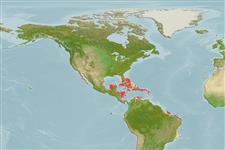Environment: milieu / climate zone / depth range / distribution range
पारिस्थितिकी
समुद्री प्रवाल-भित्ति संयुक्त. Tropical
Western Atlantic: Bermuda and southern Florida, USA to Bahia in Brazil.
आकार / वज़न / Age
Maturity: Lm ? range ? - ? cm
Max length : 18.0 cm TL पुल्लिंग / अलिंग; (Ref. 7251)
Inhabits sandy areas and seagrass beds, usually bathed by clear, oceanic waters. Feeds on small fish and invertebrates (Ref. 42064).
Life cycle and mating behavior
Maturities | पुनरुत्पत्ति | Spawnings | Egg(s) | Fecundities | लार्वा
They migrate en mass towards the open sea and have leptocephalus larvae.
Robins, C.R. and G.C. Ray, 1986. A field guide to Atlantic coast fishes of North America. Houghton Mifflin Company, Boston, U.S.A. 354 p. (Ref. 7251)
IUCN Red List Status (Ref. 130435)
Threat to humans
Harmless
Human uses
मात्स्यिकी: कोई रुचि बग़ैर
साधन
Special reports
Download XML
इंटरनेट स्रोत
Estimates based on models
Preferred temperature (Ref.
123201): 25 - 28.1, mean 27.4 °C (based on 604 cells).
Phylogenetic diversity index (Ref.
82804): PD
50 = 0.7500 [Uniqueness, from 0.5 = low to 2.0 = high].
Bayesian length-weight: a=0.00102 (0.00046 - 0.00225), b=3.06 (2.88 - 3.24), in cm total length, based on all LWR estimates for this body shape (Ref.
93245).
Trophic level (Ref.
69278): 4.0 ±0.63 se; based on food items.
Fishing Vulnerability (Ref.
59153): Low vulnerability (10 of 100).
Nutrients (Ref.
124155): Calcium = 60.8 [31.0, 123.7] mg/100g; Iron = 0.54 [0.31, 1.04] mg/100g; Protein = 18.2 [15.9, 20.9] %; Omega3 = 0.155 [0.065, 0.457] g/100g; Selenium = 38.2 [17.0, 82.0] μg/100g; VitaminA = 177 [46, 657] μg/100g; Zinc = 1.4 [0.9, 2.0] mg/100g (wet weight);
